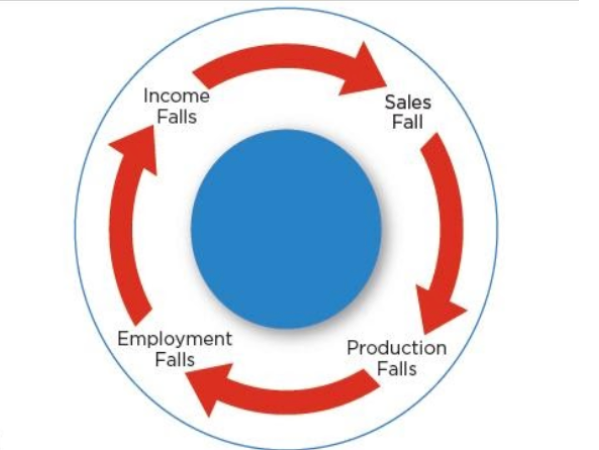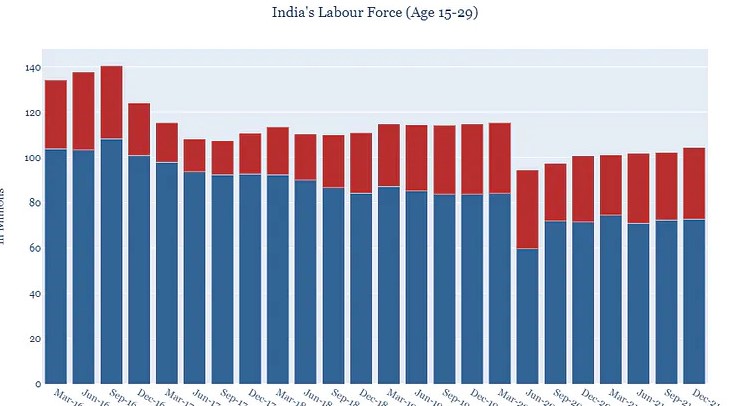In 2021, I had written that the COVID-19 pandemic would have substantial implications on the Nations and Societies as the World War II had and that’s proving to be right - refer to India’s difficult neighbourhood https://www.bharatamrising.com/india-s-difficult-neighourhood and also Did We Know Our Room Was Full of Dust - I? https://www.bharatamrising.com/challenges-features-2/did-we-know-our-room-was-full-of-dust
The entire world now appears to be in the grip of economic slow-down if not recession. Many developing economies are facing the heat and some of them are our neighbours: Sri Lanka, Myanmar, Nepal and Pakistan.
Vicious Circle of Recession/ Economic Crisis.
The economic crisis of Sri Lanka has resulted into an unprecedented political crisis, as the elected President has been forced to flee, by his own people, who elected him a few years back. Bad decisions like sudden banning chemical fertilizers to encourage organic farming that hit the country’s farm sector and triggered a drop in the critical rice crop, huge expenditure on infrastructure which did not generate revenue, country’s lucrative tourism industry and foreign workers’ remittances sapped by the pandemic, pushed Sri Lanka into a vicious circle of debt, reduced income, reduction in foreign exchange reserves, inflation and balance of payment crisis.
Decisions taken to manage the crisis did not work because of corruption and Russia – Ukraine war. “Sri Lanka is a classic twin deficit economy,” said a 2019 Asian Development Bank working paper. “Twin deficits signal that a country’s national expenditure exceeds its national income, and that its production of tradable goods and services is inadequate”.
Ruchir Sharma, a renowned Indian author of an international bestseller,The Rise and Fall of Nations, who is also a contributing op-ed writer at the New York Times, Wall Street Journal and the chief global strategist at Morgan Stanley Investment Management, wrote ;
“one of the major causes of fall is when the Nations invest in non-productive schemes which do not get them the desired revenue”. For instance, the Hambantota sea-port was economically unviable and could not generate enough revenue for Sri Lanka to repay the huge loan from China and the accrued interest, so much so that they had to hand over the port on a 99-year lease to China. The network of roads and bridges constructed through loans could not generate the revenue as the tourism suffered first due to the 2019 terrorist attack and then due to the pandemic.
Let’s compare India’s situation with that of Sri Lanka. Are we not indulging excessively in building things which may not generate enough revenue, particularly when we are going through difficult times? Think of central vista project or huge statues being constructed to get votes, this is what Rajapakse also did.
Please refer to Figure 1 to understand vicious circle of Economic crisis. Pakistan is also nearing the crisis and is now in the grip of this same vicious circle.

What has Prompted some to warn of Danger.
Although this Srilankan crisis has encouraged many to warn that India may also face the same collapse, however, Let me at the outset clarify that it’s not easy for a 3 trillion economy to get trapped into a vicious circle. At the same time, we also need to assess our current situation and judge if we are moving in a direction, which may bring pain to us.
- The 2016 demonetisation hit the unorganised sector the hardest, causing loss of jobs and initiating a spiral effect in which consumption declined due to loss of earning, particularly in villages. Nearly 90 percent of the workforce in India is engaged in the informal sector to earn their livelihood and they are highly cash dependent and cash sensitive (Figure 2). Massive lay-offs and weak economic sentiment dented GDP growth. According to most estimates, there was nearly a 2 percent decline in country’s GDP growth due to demonetisation.
- A rushed GST rollout further hit the MSMEs and unorganised sector which had not recovered from the demonetisation setback. Small-scale businesses must pay the expense of compliance, which led to closures and disruptions.
- COVID-19 shrunk the Indian economy by almost 23% The Third shock came in the form of Covid. Due to the sudden lock down during April-June 2020 and only by end of March 2022 the economy could reach the output level of April 2019-March 2020.
- In 2020, an estimated 10 million migrant workers returned to their native places after the imposition of the lockdown. The surveys conducted by the Centre for Monitoring Indian Economy shows a steep rise in unemployment rate, in the range of 7.9% to 12% during the April-June quarter of 2021. Millions of jobs were lost and many are now employed in low-paying jobs, which has adversely impacted consumption in both rural and urban areas.
- Russia-Ukraine war has pushed up fuel prices.The retail inflation jumped to an 8-year high of 7.8% due to higher oil prices and increased food inflation. This has further impacted Indians, especially the poor who will be cutting back on the necessities like food and clothes.
- Global growth is now slowing down due to the disruptions from the ongoing Russia-Ukraine war. This will dampen global demand for India’s exports and rising commodity prices like that of food and fuel is already pushing up imports.The Indian Rupee has dropped to record low levels of 79 to US Dollar which would make imports more expensive. India’s trade deficit (exports minus imports or how much we sell abroad minus how much we consume from abroad) is already at record high level and it may widen further.
- , Government debt as a percent of GDP is used by investors to measure a country ability to make future payments on its debt, thus affecting the country borrowing costs and government bond yields. India's Debt has increased in terms of value and many Indian states are under heavy debts. Similarly, the ratio of short-term debt (original maturity) to foreign exchange reserves increased to 20.0 per cent at end-March 2022 (17.5 per cent at end-March 2021). This has also to be viewed in relation to the sliding value of Rupee against Dollar.
Thus, in the last few years all these factors outlined above have impacted the following and place India in a difficult position:
- Employment
- Prices or inflation
- Household demand.
- Trade deficit.
Figure 2. Unemployment .

Actions taken by RBI and the Govt.
The recent policy actions taken by the Reserve Bank of India (RBI) and the government indicate that we are in the middle of troubled times:
- RBI increased the interest rates to check the rising inflation. But this rise in prices is due to supply problems and hence, rising interest rates will do little to address the supply issues.
- The central government in a bid to control the wheat prices within Indiahas banned exports of wheat, which would hurt the farmers.
- The central government reduced the excise duty on petroleum products, once again to control the elevated fuel prices and check inflation caused by the oil prices.
- It raised its basic import duty on gold to 12.5% from 7.5%, to dampen domestic demand for gold and bring down the trade deficit to save foreign exchange.
- The RBI announced an arrangement for domestic traders to settle imports and exports in rupees. This will help the trade with Russia and, also promote growth of global trade with emphasis on exports from India.
- The RBI has also taken steps to attract more foreign exchange from Indians living abroad to add to the declining foreign exchange reserves.
Today we are in a situation where on the one hand there are global recessionary pressures because demand is falling but at the same time the prices are going up. A noted Indian Economist and a Columnist Swaminathan Aiyar said –
“We are perhaps better positioned to withstand the problem than some other countries. We will not collapse like Sri Lanka or Pakistan but we are certainly in trouble”.
So, We may not have entered the vicious circle, but we may be very close to it (Figure 1 above ).
Economic Crisis has Many Dimensions.
Economic crisis has socio and political dimensions as well and so the problem has to be viewed in its entirety. For instance, in Srilanka, we witnessed that Economic crisis led to a Political crisis, where in, a popular Govt of Rajapakse who was hero a few years back, who could do no wrong has been compelled to flee by people themselves. The same happened in Pakistan also.
In view of the above, the biggest challenge is that of unemployment and not only unemployment but more importantly a reduction in work force, implying that lots of workers especially the youth who have stopped looking for jobs and have left the workforce force discouraged. (Figure 2 above ,Also refer to my article ; Are we witnessing the Manifestations of Covid https://www.bharatamrising.com/challenges-features-2/the-political-masters )
According to NSSO survey, Over 12.5 million 15-29-year-olds not only lost employment, but they also stopped looking for new jobs. India’s job crisis has been worsening since 2016.
Now with the growth slowing down due to various reasons discussed above, this will hit the youth hard and, we noticed the signs of discontentment recently with protests erupting in Bihar over irregularities in the railway exam and, in major states over the ill-conceived Agneepath scheme.
Given the poor law and order situation in the country, deteriorating communal environment in the country, huge corruption ( who footed the bill of so many MLAs who moved from Mumbai to Gujarat to Guwahati to Goa and then back to Mumbai), perks enjoyed by politicians (Figure 3) at a time when people’s salaries are not growing; one spark can get us into the same vicious circle like the one that pushed Sri Lanka.
Figure 3 ; Perks enjoyed by MLAs.
|
||||||||||||||||||||||||||||||||||||||||||||||||||||||||||||||||
Conclusion
Just to highlight how things can go wrong , please read the speech of Raja, a DMK political leader and erstwhile Cabinet Minister with the Govt of India, who spoke these words when CM of Tamil Nadu was on the dais. He said ;
“ I am telling Amit Shah and the Prime Minister with utmost humility, I implore you in the presence of (our) leaders on the dais, our Chief Minister is journeying on the path of Anna (C N Annadurai, former Chief Minister and DMK founder), do not push us on the path of Periyar. Do not make us seek a separate country, give state autonomy and we will not rest till then “. He, while Referring to Union Home Minister Amit Shah’s statement that Hindi was the only language that could unite India, Raja “reminded” him that East Pakistan seceded from Pakistan only because Urdu was “imposed” on the Bengali-speaking people.
Nation going through communal discord and regional discords can provoke and inflame strong separatist tendencies when there is economic turmoil which can cause irreparable damage to the country.
It is therefore very essential for all those who love the country to just give up hatred and make sure that the communal environment does not deteriorate, any further.
A united family can face any turmoil and still live happily and face the crisis , this is applicable to Nation as well.
